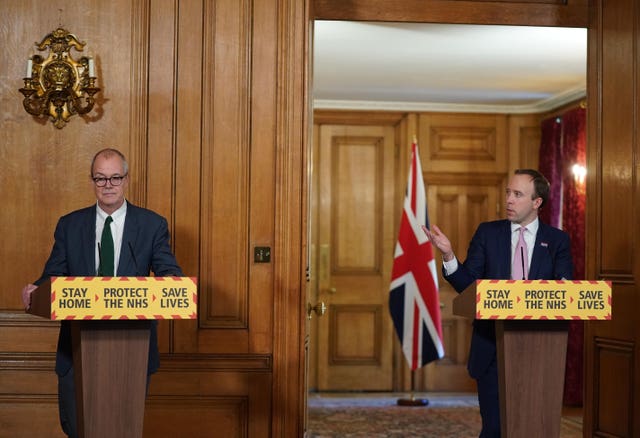Matt Hancock has claimed the UK lockdown “truly started” on March 16, seven days before the strict shutdown announced by Prime Minister Boris Johnson.
The Health Secretary attempted to bat away Labour questions highlighting comments from Sir Patrick Vallance, the Government’s chief scientific adviser, in which he suggested Sage advised ministers on March 16 to move to a full lockdown as soon as possible.
Shadow health secretary Jon Ashworth questioned why there was a seven-day delay in taking such a decision, with party colleague Zarah Sultana (Coventry South) warning this could have cost “thousands of lives”.
But Mr Hancock told the Commons: “On March 16 I said to this House, and it was welcomed by the frontbench opposite, ‘today we’re advising people against all unnecessary social contact with others and all unnecessary travel’.
Truly started
“That is when the lockdown truly started.”
PM Mr Johnson addressed the nation on March 23 to announce a full lockdown, with the UK public told they were only allowed to leave their homes for limited reasons, including shopping for food, exercise once per day, medical need and travelling for work when absolutely necessary.
All shops selling non-essential goods were also told to close while gatherings of more than two people in public were banned.
Mr Ashworth earlier said: “Why did it take a further seven days for the Government to implement lockdown if Sage was advising March 16?”
Mr Hancock replied: “Of course March 16 is the day when I came to this House and said that all unnecessary social contact should cease.
“That is precisely when the lockdown was started and… it is unusual to be attacked for saying exactly the same as the chief scientific adviser.”
Sir Patrick, giving evidence to the Commons Science and Technology Committee, was asked about why the lockdown did not happen earlier.

He replied: “OK, and two things on that.
“The first is quite an important one, as we look back and try and decide what should or shouldn’t have happened, is we focus on lockdown, whereas actually there were a series of steps in the run up to lockdown.
“We actually started with an isolation of people coming from China.
Isolation
“But, the main ones were case isolation, household isolation, then recommendations not to go to pubs and theatres and so on.
“And if you look at what the behaviour change was, it was quite extreme over that period so there’s a number of things that happened.
“But your point about timing is absolutely right.
“And when the Sage subgroup on modelling, Spi-M, saw that the doubling time had gone down to three days, which was in the middle of March, that’s when the advice which Sage issued was the remainder of the measures should be introduced as soon as possible.

“And that advice I think was given on March 18, or March 16.
Data
“But it’s when those data became available.
“Now looking back you can see the data may have preceded that, but the data were not available before that.
“That knowledge of the three-day doubling rate became evident during that week before.”
Sir Patrick went on: “But it’s mid-March when it became obvious that this was accelerating faster, and we were closer than it had seemed, and that moment was when the advice changed to say, implement the measures as soon as possible.”
He added: “The advice changed because the doubling rate of the epidemic was seen to be down at three days instead of six or seven days.”

